| | Tech Tips - Business IT Support Tips
Posts Tagged ‘verizon’
Friday, April 13th, 2012
 A small to medium sized business today needs to move at the speed of light in order to remain competitive. All too often, employee productivity is tied directly to the responsiveness of the office internet connection. With remote workers, social media, online apps, cloud databases, email, and other web based technologies forming the hub of a company’s communication system it is critical to maximize internet speed in order for work to be completed quickly. A small to medium sized business today needs to move at the speed of light in order to remain competitive. All too often, employee productivity is tied directly to the responsiveness of the office internet connection. With remote workers, social media, online apps, cloud databases, email, and other web based technologies forming the hub of a company’s communication system it is critical to maximize internet speed in order for work to be completed quickly.
Internet speeds have come a long way from the days of Dial-up and many different technologies have emerged to help connect your small to medium sized business computers to the Cloud. The most common of these technologies for an office include DSL, Dedicated T1, Cable, and Cellular. With each differing technology comes a range of different features, varying reliability, and different levels of performance, price, customer service and ease of use.
When the time comes to evaluate an internet provider for your office and business technology needs, it is important to weigh everything together. The overall speed, price, reliability, provided features, and even the reputation of the service providers are important when it comes to making the final decision. Here is a general overview of the main differences between various types of data technologies for your office:
Rated by Speed from Slowest to Fastest in a Typical Environment
- DSL (usually the slowest)
- Cellular
- T1
- Cable Broadband (usually the fastest)
Average Prices from Least to Most Expensive
Average Reliability from Least to Most Reliable
While the least expensive choice for business solutions is DSL, it is usually the slowest speed which can have a crippling effect on workplace productivity. Whenever taking speed into consideration, it is important for a professional to evaluate the number of computers, devices, and what they will be used for. That information can be compared to speed ratings for the various types of internet available.
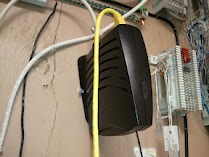 This is a standard cable modem Another important point to evaluate with intended usage is the need for 24×7 connectivity. In some cases, for example if an email server or web server is part of the office technology deployment, it is more important to lean towards the more reliable solutions to avoid any disruption in services. The most reliable and expensive solution is a dedicated T1. A T1 maintains a connection to the Cloud at a constant speed with 99.99% up-time. While this is the most expensive choice, it has the highest probability of working when you need it.
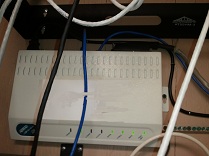 T1 TDM router If mobility is what you’re after, you’re going to want to take a look at cellular. Cellular data technologies allow you to take your work with you wherever you go. And last but not least, the best bang for your buck overall is Cable broadband. This is a great choice if you need a lot of speed at a great price.
Are you moving offices, looking at starting up a new office, or just need to upgrade your existing office? my PC Techs is a locally owned, Phoenix, Arizona based technology consulting firm. We have special connections to all of the big data providers in the area, including Cox, Integra, Verizon, and Centurylink (formerly Qwest). We can help your business evaluate speed, price, and reliability and decide between DSL, T1, Cable, or Cellular. Most importantly, we will help you get the best price and make the installation easy for you.
Speed up your office and get more work done in less time for less money. That’s what we do at my PC Techs. We help your business increase productivity, save time, and save money. Don’t lose another minute of productivity due to slow or unreliable Internet access! Give our experts a call today @ (602) 456-0150 for a free consultation and find out for yourself why our clients rave about our superior service and affordable prices.
Tags: business, cable, cellular, centurylink, consultant, cox, data, dsl, fast, integra, internet, internet access isp speed, office, performance, price, qwest, reliability, speed, t1, verizon
Posted in Tech Club General | 1 Comment »
Wednesday, December 21st, 2011
 A client recently reported a problem with 10 user laptops. Users could receive email, but sending email resulting in a 550 5.7.1 error via bounce back. Accounts were configured through Outlook 2010 with SMTP to a corporate Exchange server. A client recently reported a problem with 10 user laptops. Users could receive email, but sending email resulting in a 550 5.7.1 error via bounce back. Accounts were configured through Outlook 2010 with SMTP to a corporate Exchange server.
Interestingly enough the laptops were connected to the internet with Verizon 4G modems. They were able to download files, surf the internet, and do pretty much everything else as normal. No settings on the laptop, Outlook 2010, or the Exchange server had changed from one day to the next.
We ruled out the Exchange server by sending from Outlook Web Access as the user. We ruled out the user SMTP account by sending from a stand-alone desktop machine as the user. We then ruled out the laptops themselves by connecting them to a hard wired LAN connection and sending from Outlook 2010 without any problem. The only time we experienced the 550 5.7.1 error was when connected using Verizon 3G or 4G.
Could these recent problems with the Verizon network have something to do with it? We updated the VZAccess Manager software to the absolute latest version (Help / Check for Updates). During that process the firmware of the device was updated as well.
Surprisingly, after the Verizon software and modem updates it was possible to send email again. Hopefully this helps anyone else who is having trouble sending email through SMTP while connected to a Verizon 3G or 4G modem. Upgrade your modem!
>> Did you like this article? Ping it!
Tags: 3g, 4G, 5.7.1, 550, email, error, network, smtp, software, update, upgrade, verizon
Posted in Tech Club General | No Comments »
Thursday, November 10th, 2011
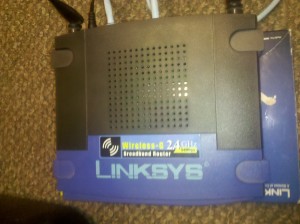 The Challenge: How can you create a wired LAN with an independent network when: The Challenge: How can you create a wired LAN with an independent network when:
> There is no available CAT5 cable leading to a modem or router
> The only internet connection nearby is on an established router that you can’t change settings on
> Wireless access is available in the building
One option is a cradelpoint 4G router, using a Verizon 4G modem to setup internet access for multiple computers. However, in this case, we need a solution that is not limited by the amount of data you can download before overages set in. We settled on using a spare Linksys WRT54G router. When flashing this to DD-WRT, it’s possible to set the WAN on the wireless router to client mode and connect to an existing Wi-Fi network. We could then create a LAN on the device and plug-in computers to create our own network that would use the connected Wi-Fi network signal to pull internet!
Take a look at this article “Building a Wireless Bridge” that is helpful for this type of configuration. How can our Phoenix computer repair office help you solve your office networking challenges?
>> Did you like this article? Ping it!
Tags: 4G, cable, CAT5, client mode, client router, computers, connection, cradlepoint, data, internet, internet access, lan, linksys, modem, network, router, settings, verizon, WAN, wireless, wrt54g
Posted in my PC Techs News & Events | No Comments »
Saturday, August 13th, 2011
I recently needed to find a mobile internet solution with a good amount of bandwidth, support for a lot of users, and one that I could easily move from place to place. The most obvious solution was a 4G internet plan, but after several frustrating hours searching around on the internet one evening for a solution I came up empty handed.
I needed something that would handle 20+ clients connected simultaneously. Yet, as some of you already know, the web stores for Sprint, Verizon, etc. only sell mobile hotspot devices with their 4G plans that handle a maximum of 5 connected clients. This small number of users makes it very difficult to use the 4G device with a small room full of people, or in a small to medium sized office as a backup device for the main internet connection if it ever goes down. Verizon had the largest capacity mobile hotspot (it would connect 8 users at the same time), but even that number was too small for my needs.
The next day I stumbled upon the Cradlepoint 4G routers. It wasn’t easy to find this company through my normal search terms the night before, so they should consider an upgrade in SEO for their website! Cradlepoint sells routers and devices that greatly expand the number of clients that can connect to and use a single 3G or 4G modem. What I liked the most about their website was how easy it was to identify the product that I needed.
First of all, they have a chart the shows you exactly how many clients or users you can connect for each of their various devices. Next, on the product pages, there are technical specs that will give you a list of the hardware (modems, hotspots, phones, etc) supported broken down by cellular company.
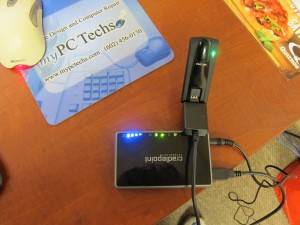 I settled on the CTR 500 for my intended usage. This device has good reviews on the internet, can utilize most wireless devices from all carriers, and will support up to 32 wireless clients (and many more wired). I found this smoking deal on Newegg for the Cradlepoint, along with a lot of great reviews: http://www.newegg.com/Product/Product.aspx?Item=N82E16875997455 I settled on the CTR 500 for my intended usage. This device has good reviews on the internet, can utilize most wireless devices from all carriers, and will support up to 32 wireless clients (and many more wired). I found this smoking deal on Newegg for the Cradlepoint, along with a lot of great reviews: http://www.newegg.com/Product/Product.aspx?Item=N82E16875997455
Once I knew which Cradlepoint model I needed to buy, I then used the supported devices list on the CTR 500 webpage to look at different carriers and see what was available (AT&T, Sprint, Verizon). You will find that many products listed on the Cradlepoint product page are older devices no longer being offered by the various carriers. I had to cross-reference the devices supported by the Cradlepoint with those that were actively being sold by the cell companies.
I knew that I needed 4G, so the most important thing I had to do was look over the 4G coverage maps for the cellular companies in my area. Take a look at these 4G Coverage Maps:
Verizon 4G Coverage Map
Clear 4G Coverage Map
T-Mobile 4G Coverage Map
Sprint 4G Coverage Map
AT&T 4G Coverage Map
Unfortunately, Verizon is the only cell company in my area that offers reliable 4G coverage. That alone finalized my decision and forced me to go with Verizon and to choose a compatible Verizon device for my Cradlepoint. I say unfortunately because Verizon recently stopped selling unlimited data plans, opting instead to limit their data plans to a maximum cap of either 5G or 10G per month. If you go over that purchased limit, they will charge you an additional $10 per GB. AT&T does the same thing, limits your data plans and charges you for overages. T-Mobile claims to offer unlimited data, but that’s simply not true – they just throttle (rate limit) your bandwidth after you cross a certain amount of usage each month. Since Sprint is the only carrier that sells unlimited 3G and 4G data plans I really wanted to sign on with them, but their 4G coverage is nowhere to be found in my area. If you have Sprint in your area and they provide 4G, jump on it!
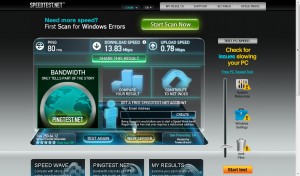 End result? I had to settle for a Verizon 10GB per month plan. Watching bandwidth usage on a device like this will be critical when you have multiple users connected. Fortunately, the CTR 500 has a lot of sophisticated controls over the network and I am still playing around, creating rules and firewalls to limit what connected users are allowed to do with the network. There are calculators out there that can help you determine the amount of data you’ll need to accommodate 32 simultaneous internet users. A 4G device with a 5GB or 10GB cap can only be in use for a short amount of time before your limitations on the plan have been reached, so this solution is best for short, mobile internet use (like seminars) or as a backup internet option when the main connection fails. End result? I had to settle for a Verizon 10GB per month plan. Watching bandwidth usage on a device like this will be critical when you have multiple users connected. Fortunately, the CTR 500 has a lot of sophisticated controls over the network and I am still playing around, creating rules and firewalls to limit what connected users are allowed to do with the network. There are calculators out there that can help you determine the amount of data you’ll need to accommodate 32 simultaneous internet users. A 4G device with a 5GB or 10GB cap can only be in use for a short amount of time before your limitations on the plan have been reached, so this solution is best for short, mobile internet use (like seminars) or as a backup internet option when the main connection fails.
So far I have been pretty happy. I did some recent speed tests with the device and found that I was getting many times greater speed than I can get on my T1 line in the office.
>> Did you like this article? Ping it!
Tags: 4G, AT&T, backup, bandwidth, carriers, chart, clear, clients, connect, connection, coverage maps, cradlepoint, hotspot, hotspots, internet, mobile, modems, move, newegg, office, people, phones, plan, product, reviews, router, same time, simultaneously, solution, sprint, users, verizon, verizona
Posted in Tech Club General | No Comments »
WE WORK HARD FOR YOU, BUT DON'T JUST TAKE OUR WORD FOR IT!
We've helped over 1,000 satisfied businesses throughout the Phoenix valley, click here to view some of their testimonials:

©2010 my PC Techs is owned and operated by Leo Polus, L.L.C., concept by Andre Morris |
| |
 A small to medium sized business today needs to move at the speed of light in order to remain competitive. All too often, employee productivity is tied directly to the responsiveness of the office internet connection. With remote workers, social media, online apps, cloud databases, email, and other web based technologies forming the hub of a company’s communication system it is critical to maximize internet speed in order for work to be completed quickly.
A small to medium sized business today needs to move at the speed of light in order to remain competitive. All too often, employee productivity is tied directly to the responsiveness of the office internet connection. With remote workers, social media, online apps, cloud databases, email, and other web based technologies forming the hub of a company’s communication system it is critical to maximize internet speed in order for work to be completed quickly. 




 I settled on the
I settled on the  End result? I had to settle for a Verizon 10GB per month plan. Watching bandwidth usage on a device like this will be critical when you have multiple users connected. Fortunately, the CTR 500 has a lot of sophisticated controls over the network and I am still playing around, creating rules and firewalls to limit what connected users are allowed to do with the network. There are calculators out there that can help you determine the amount of data you’ll need to accommodate 32 simultaneous internet users. A 4G device with a 5GB or 10GB cap can only be in use for a short amount of time before your limitations on the plan have been reached, so this solution is best for short, mobile internet use (
End result? I had to settle for a Verizon 10GB per month plan. Watching bandwidth usage on a device like this will be critical when you have multiple users connected. Fortunately, the CTR 500 has a lot of sophisticated controls over the network and I am still playing around, creating rules and firewalls to limit what connected users are allowed to do with the network. There are calculators out there that can help you determine the amount of data you’ll need to accommodate 32 simultaneous internet users. A 4G device with a 5GB or 10GB cap can only be in use for a short amount of time before your limitations on the plan have been reached, so this solution is best for short, mobile internet use (





